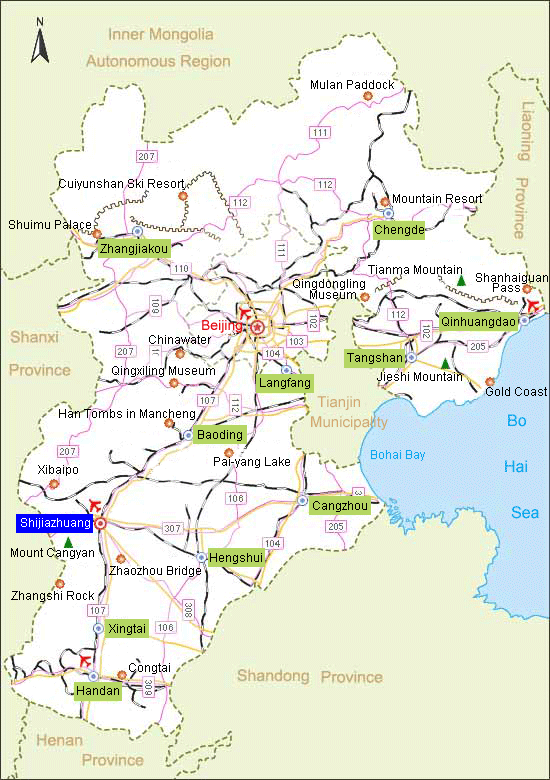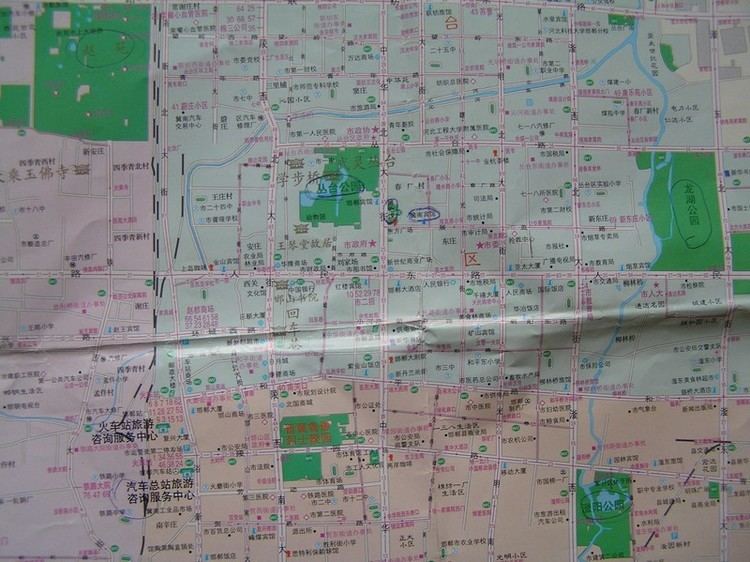Country China Population 1.33 million (2000) | Area 12,068 km2 | |
 | ||
Colleges and Universities Hebei University of Engineering, Handan College, Hebei Engineering University | ||
Map of Handan
Handan (Chinese: 邯郸) is a prefecture-level city located in the southwestern part of Hebei province, China. It borders Xingtai on the north, and the provinces of Shanxi on the west, Henan on the south and Shandong on the east. At the 2010 census, its population was 9,174,683 inhabitants whom 2,845,790 lived in the built-up (or metro) area made of 3 urban districts, Handan and Yangyan counties, and Shahe City in Xintai municipality, largely being conurbated now.
Contents
- Map of Handan
- 1000 victims protest handans property market collapse
- Planning design for chinese idiom culture industrial park in handan city hebei province frontop
- History
- Administration
- Climate
- Economy
- Air pollution
- Ethnic minorities
- Religion
- Notable people
- Twin cities
- References

1000 victims protest handans property market collapse
Planning design for chinese idiom culture industrial park in handan city hebei province frontop
History
The city of Handan was the capital of the State of Zhao during the Warring States period (475−221 BCE), after the capital moved from Zhongmu. It has held the name "Handan" since at least the 1st millennium BCE. King Wuling of Zhao turned Zhao into one of the Qin state's most stalwart foes, pioneering the use of walls to secure new frontiers (which would inspire the eventual construction of the Great Wall of China). The city was conquered by the State of Qin after the virtual annexation of Zhao by Qin except for the Dai Commandery. The first emperor of China, Qin Shi Huang was born in Handan, the child of a statesman from the state of Qin and after successfully conquering Zhao he ordered all enemies of his mother to be buried alive. The conquest of Zhao, particularly the Qin siege of Handan, is featured extensively in Chen Kaige's classic film, The Emperor and the Assassin.
Handan was still regarded as a cultural and commercial centre during the Western and Eastern Han dynasties (206 BCE−220 CE). It slowly declined, perhaps because of the numerous battles that ravaged northern China following the Han Dynasty, but maintained a reputation for its fine Cizhou ware well into the Qing dynasty (1644–1911). It was also the birthplace in the 19th century of Yang-style t'ai chi ch'uan, one of the five major schools of tai chi in China.
Though much of Handan's ancient history is no longer visible, it still has some attractions, most derived from Zhao folklore such as the road into which Lin Xiangru, courier of the precious jade He Shi Bi, backed in order to let his nemesis Lian Po pass first, as well as the location in which Lian Po begged for Lin Xiangru's forgiveness. Modern-day Congtai Park is located on the site of the historical Zhao court. Next to Congtai Park is the legendary "Xuebu Qiao" (学步桥), or "Learning to Walk Bridge". Legend has it that a noble from the state of Yan heard of a particularly elegant manner of walking unique to Handan. Arriving in Handan, he spent weeks trying to master the Handan style of walking on a bridge, only to fail. In the process, however, he had forgotten how to walk normally and had to crawl back to Yan. This story inspired the Chinese expression, 邯郸学步, which means learning something difficult too intensely, thereby forgetting the basics in the process.
The nearby Xiangtangshan Caves contain massive Buddha statues carved into the mountainside, some dating to the 6th century. Many of these statues were severely vandalised by occupying Japanese forces during World War II. Handan was prized by the Japanese invaders for its coal reserves.
Administration
The population at the 2010 census was 941,427 for the 3 urban districts, 2,845,790 for the built up area and 9,174,683 for the entire Prefecture-level city area of 12,068 km2 (4,659 sq mi).
The municipal executive, legislative and judiciary are situated in Congtai District (丛台区, Cóngtái Qū), as well as the CPC and Public Security bureaux.
Climate
Handan has a cold semi-arid climate (Köppen BSk)
Economy
Industrial growth in the city was due to its communication and transport activities. Coal mines at Fengfeng provide power for Handan's iron, steel and textile mills. Chemical and cement plants along with other industries also benefit. The GDP per capita in Renminbi (人民币), aka yuan (元) was estimated at ¥13,449 in 2005.
Air pollution
According to a survey by "Global voices China" in February 2013, Handan is one of China's most polluted cities due to heavy industrial outputs.
Ethnic minorities
According to Handan government in 2007, 40 ethnic groups were present in Handan. Ethnic minorities represent 50,000 people, among which 48,000 Hui. There are 22 Hui schools and 5 Hui junior high schools in Handan.
Religion
The most widespread religion in Handan is Chinese folk religion, including Taoism and Buddhism.
In 2013, there were more than 150,000 Catholics in Handan according to the Catholic Church, in the Roman Catholic Diocese of Yongnian. Mother of Grace Cathedral in Daming County was built in 1918. The most recent church was built in 2007.
There are also 300,000 Protestants. The largest Protestant church is on Qianjin Avenue (邯郸市西堂) and was built in 1997. The oldest church was on Congtai Street and was built in 1920 by Americans. The church was destroyed 2009 by the local government. A new church was built in 2011.
According to the local government 30,000 Hui Muslims live in the prefecture of Handan.
